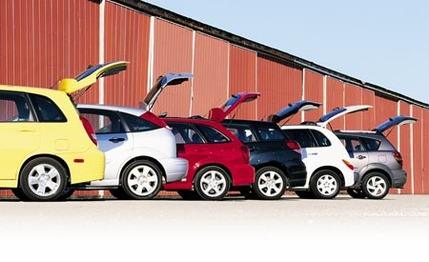
 Comparison Tests
Comparison Tests
It's a sign of desperation in the auto industry, and of tapped-out imaginations in the marketing departments, when the season's hot new category is the "crossover vehicle."
Whatever.
Actually, that's what the industry is trying to say: "Whatever you want, these cars will do it."
Oh, yeah? Since when has fuzzy thinking ever created a great car?
Instead of latching onto the season's buzzword and building a test around it, we returned to a time-honored axiom: bigger on the inside is better.
We've been noticing that a number of automakers have created extra-roomy models on their small-car platforms. Each company seems to have its own formula. There's no common denominator to describe a class of cars distinct from all others. Well, they're all sort of loaf-shaped, if that helps. But think of them as station wagons in denial, and you'll be close.
As a concept, we're talking personal-transportation boxes, size small. Arguably, the old Chrysler Corporation put the idea into play with its 1998 Chrysler Pronto Cruizer concept car, a retro-flavored high-roof hauler that went to real time as the 2001 PT Cruiser. This little five-door has made everybody a winner. It's been huge for DaimlerChrysler, which turned out 144,717 of them last year, more than the combined total of Plymouth and Dodge Neons on which the Cruiser is based. And the rest of us get to smile at every one we see on the road. Has practical transport ever been more exuberant to the eye?
For now, at least, other makers are content to package their extra space in less imaginative wrappings. Newest on the scene, and dated 2003, are the Corolla-based high-roof twins from the Toyota/GM joint venture, the Toyota Matrix and the Pontiac Vibe. They're almost identical under the skin, differing only in upholstery and exterior sculpting.
That said, the options list offers plenty of room to go your own way (both draw from a similar list). To show the possibilities, we've cast the Matrix in the sporting role, with the high-output 180-hp four-cylinder, six-speed manual, and 17-inch pavement-gripper tires. The Vibe plays the tourer, with the standard 130-hp four, five-speed manual, plus a GPS navigation system and a CD changer. All-wheel drive is available on both (with the mild engine), but we're sticking to the base front-drive configuration for this comparo.
Also fresh-baked for 2003, and making its C/D debut, is the Suzuki Aerio SX. The SX counters the PT Cruiser's retro theme with a sort of did-it-myself charm. You could tell folks you made this car in the privacy of your own workshop, and they'd readily believe you, at least till the malls become thick with them. And thick they will become, because the SX packs the most sought-after feature in automobiledom-a rock-bottom price.
Two older models also got the box makeover for model year 2002. Mazda's Protegé four-door sedan has long been a favorite for its quality construction and sporty moves. The Protegé5 repackages that familiar goodness under a rakishly italicized station-wagon roofline.
Ford already had both a notchback four-door and a station wagon in its Focus line. New this year is a loaf-shaped five-door created by adding two more doors to the ZX3 coupe. Luggage capacity goes up 44 percent compared with that in the notchback.
Ford has been careful not to use the crossover moniker, at least not for this model within earshot of us, but Dearborn is quick to tell us that the ZX5 will appeal to "sophisticated young adults." That's exactly what the crossovers say, too.
Maybe. But we notice lots of graybeards driving PT Cruisers, and they're grinning like kids. Astute cars appeal to everyone.
For sure, these boxes make an astute promise. "You can have it all," they say-style, seating for friends, space for your stuff, and driving fun-for less than $20,000. That's a tall promise. Can they possibly deliver?
Let's check the scoreboard.